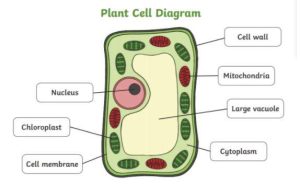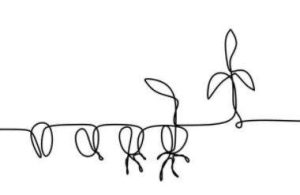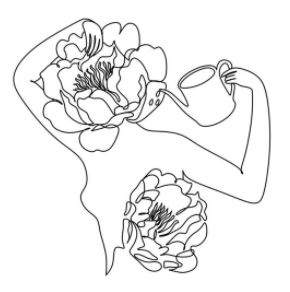Home
What is Growth?
Growth and development are things that every organism does. And although they are two completely different things, they are often mentioned in the same breath. Growth is the increase in size and weight of the organism.
Any organism that consists of several cells does this by making new cells. Organisms that consist of only one cell grow by cell elongation: they make their only cell bigger by producing more cell fluid.

Development is a more complex story. It is not about mental or social development but about changes that occur in the organism’s structure. An organism does this to perform the tasks it needs to perform even better, or even because new organs need to be added.
The Spark of the Seed
How does a miniscule clump of four apparently identical plant cells grow into a complete plant, with stems, leaves and flowers?
For a long time, the mechanism of tissue formation in plants was unclear.
Plants are not as mobile as animals. Whereas animals can move freely, plants are anchored to the soil. This also applies to their cells. In the embryonic stage of an animal, cells can migrate, whereas the very young plant cells are immovably bound together.
The plant embryo grows by strictly controlled cell divisions in one of three dimensions – forward, sideways or upwards. At the same time, groups of these cells must also acquire specific ‘identities’ that ultimately lead, for example, to wood or vascular tissue.
Until now, it was completely unknown how these two crucial processes, growth and patterning, are controlled during tissue formation in such a way that the tissue remains stable despite growth.
The biochemists discovered that pattern formation of vascular tissue already takes place while the early embryo still only has four vascular tissue cells.
Parts of a Plant Cell

- Nucleus – contains the cell DNA and controls what the cell does.
- Cell wall – gives strength to a plant. Animals have bones or other ways of keeping their bodies in a specific shape. Plants don’t have these, and they also have to grow upwards against gravity, so they use cell walls to keep their shape.
- Cell membrane – you see in the picture is a small layer inside the cell wall. It ensures that the cytoplasm stays inside the cell and does not run out. The cell membrane also prevents other substances from entering the cell.
- Cytoplasm – is a liquid that would run away if the cell membrane didn’t stop it. As you can see from the picture, all the organelles you find in a cell are “floating” inside the cytoplasm.
- Chloroplast is responsible for photosynthesis within plants, whereby water and CO2 are converted into glucose and oxygen utilizing sunlight. This produces the oxygen that we all breathe, and it provides the plants that we eat with the nutrients to grow. Leaf chloroplasts are not found everywhere in plants. Near their roots, where there is no sunlight, you will not find them. They are mainly found in the leaves of plants and, for example, in the stems of flowers.
- Chlorophyll – is a plastid, of which there are 3 types. If you look at the picture, you see a starch grain. This is another plastid; when a plant has excess energy, it stores it in starch grains. A third plastid that is not shown in the picture is dye grains. They give bright colors to flowers and, for example, the red color to tomatoes or orange to carrots. Plastids can change their function; if a green banana turns yellow, the chloroplasts change into dye granules. But if a potato is exposed to light, it can also turn green because its starch granules change into chloroplasts.
- Large Vacuole – often takes up more than half of the cell and, like the cell wall, plays a role in keeping plants in shape. The vacuole is filled with moisture, so much so that it exerts pressure on the cytoplasm around it and the cell wall, strengthening it. The vacuole can also be used to store nutrients, for example, in seeds.
- Mitochondria – the powerhouse of the cell and where respiration takes place
How Plants Grow
When plants grow, it means that the size of the plant increases. Plants grow by forming new cells and increasing the size of existing cells.

A plant grows when photosynthesis exceeds respiration. Photosynthesis is the conversion of light energy into sugar molecules. Therefore, light is needed for photosynthesis.
The process of photosynthesis takes place in the chlorophyll of the plant.
Plant Respiration
Respiration in plants amounts to burning sugar molecules:
- This releases energy for the growth and life of the plant
- Respiration takes place day and night
- The leaves can be considered as the lungs of a plant
If you remove the lowest leaves, a plant can absorb more nutrients. And so it becomes heavier and more extensive.
But beware: what you take away above the ground corresponds to the share of dying roots.
Growth Rate of Plants
Six factors influence the growth rate of plants:
- Nutrients
- Water supply
- Oxygen and CO2
- Temperature
- The light intensity
- The humidity
All these growth factors are closely related to each other. For optimum growth, these factors must be in the right proportion to each other.
The limiting factor determines the possibilities for maximum growth. Do you improve this limiting factor? Then you will achieve better growth until another limiting factor slows it down.
Plant Nutrients
Nutrients or fertilizers can be one of the limiting factors. A plant consists of about 90% water. The rest is dry matter. Most of the building blocks for dry matter are sufficiently available in the atmosphere. There is no need to add them in the form of fertilizers.
With fertilizers, we can only influence growth by about 6%.
How Water Affects Plants
A plant only absorbs nutrients in the form of moisture through the roots. Maximum growth is only possible with an undisturbed water intake. For life on earth, water is at least as valuable as gold.
Water absorption mainly takes place via the so-called hair roots. The hair roots increase the absorption capacity of the primary roots.

At the same time, they ensure the required absorption of trace elements. You should therefore ensure that the pH value of the nutrient solution is not too acidic. After all, acid can burn the roots.
What Impact Does a Lack of Water have
Two main streams can be distinguished in the nutrient uptake. The roots absorb water and nutrients and transport them to the top of the plant. Only from there do the water and nutrients spread to the other parts of the plant.
This is why a plant first hangs its head when there is a shortage of water. For this reason, evaporation is essential for a plant because the nutrients are transported to the plant head and the upper buds, resulting in a higher yield.
Evaporation takes place through cold or warm dry air.
Oxygen
Roots consume energy for various activities. Oxygen is indispensable for respiration, where energy is released from sugar molecules.
If the water supply is too high, oxygen is dissolved in the soil, causing the roots to rot and the plant to die after a few days. We do not need to supply plants with CO2 because it is more than sufficiently available in the air.
Scientists even complain about the so-called greenhouse effect caused by CO2.
The Temperature
Soil temperature, in particular, is very important for respiration and the root activity of plants. A soil temperature of around 20 degrees Celsius is optimal.
The Importance of Air Humidity
- If the air humidity is too high, the plant cannot evaporate enough to send nutrients to the buds, which leads to a cessation of growth;
- If humidity is too low, the leaf shows signs of burning. This leads to loss of chlorophyll and reduced yield.
Therefore, young plants in the growth phase tolerate higher humidity (70-80%); however, plants in the flowering phase require lower humidity (40-60%).
The Role of Plant Protection Products
From the above, it can be seen that the roots are an essential part of the plant. The more roots a plant has, the better it grows and the higher its yield will be.
There are various biological crop protection agents nowadays that have more than proved their worth in horticulture. They encourage roots to perform their function naturally and responsibly.
It has been proven in practice that biological crop protection agents perform better than chemical pesticides.